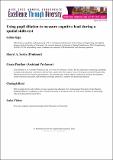| dc.contributor.author | Raju, Gibin | |
| dc.contributor.author | Sorby, Sheryl A. | |
| dc.contributor.author | Panther, Grace | |
| dc.contributor.author | Reid, Clodagh | |
| dc.contributor.author | Fisher, Luke | |
| dc.date.accessioned | 2022-11-22T10:33:05Z | |
| dc.date.available | 2022-11-22T10:33:05Z | |
| dc.date.copyright | 2022 | |
| dc.date.issued | 2022-08-23 | |
| dc.identifier.citation | Raju, G., Sorby, S., Panther, G., Reid, C., Fisher, L. (2022 August), Using pupil dilation to measure cognitive load during a spatial skills test Paper presented at 2022 ASEE Annual Conference & Exposition, Minneapolis, MN. https://peer.asee.org/41098 | en_US |
| dc.identifier.uri | https://research.thea.ie/handle/20.500.12065/4322 | |
| dc.description.abstract | This full research paper explores how spatial skills and cognitive load interact. Spatial skills allow a person to manipulate and rotate any three-dimensional object. Studies have reported that spatial skills can be a reliable predictor of problem-solving success in engineers. Despite the comprehensive literature on spatial skills, the cognitive load experienced while solving spatial items is not fully understood. Using an eye tracking device, researchers explored how the cognitive load experienced by a high spatial visualizer differs when compared to a low spatial visualizer in solving spatial tasks. Pupil dilation was recorded as a measure of cognitive load via the eye-tracking device as studies have shown that cognitive load causes a task-evoked pupillary response. Previous studies have shown that there is a linear increase in pupil dilation as cognitive load increases.
The current study was conducted in two phases. The first phase recruited 143 undergraduate engineering students from two large, public, R1 institutions. Participants completed three spatial tests. Based on their performance on the spatial tests, 35 participants were selected for the second phase of testing. While the first phase was conducted over a web conference platform, participants came in person for the second phase so that they could wear an eye-tracking device while completing further tasks. The tasks included tests in spatial and verbal analogy and solving six engineering mechanics problems with increasing levels of difficulty. Data related to gender, race, and ethnicity were collected to understand if there were differences by demographic group. The larger study aims to examine several factors, including cognitive load, for high and low spatial visualizers while solving the six mechanics problems. In this paper, analysis results from the spatial testing component of the study will be presented. | en_US |
| dc.format | PDF | en_US |
| dc.language.iso | eng | en_US |
| dc.publisher | ASEE | en_US |
| dc.relation.ispartof | 2022 ASEE Annual Conference & Exposition. Excellence Through Diversity | en_US |
| dc.rights | Attribution-NonCommercial-NoDerivs 3.0 United States | * |
| dc.rights.uri | http://creativecommons.org/licenses/by-nc-nd/3.0/us/ | * |
| dc.subject | Pupil dilation | en_US |
| dc.subject | Cognitive load | en_US |
| dc.subject | Spatial ability | en_US |
| dc.subject | Spatial skills | en_US |
| dc.title | Using pupil dilation to measure cognitive load during a spatial skills test | en_US |
| dc.type | info:eu-repo/semantics/other | en_US |
| dc.conference.date | 2022-06-26 | |
| dc.conference.host | American Society for Engineering Education | en_US |
| dc.conference.location | Minneapolis | en_US |
| dc.contributor.affiliation | Technological University of the Shannon Midlands Midwest | en_US |
| dc.description.peerreview | yes | en_US |
| dc.identifier.orcid | https://orcid.org/0000-0002-8593-1730 | en_US |
| dc.rights.accessrights | info:eu-repo/semantics/openAccess | en_US |
| dc.type.version | info:eu-repo/semantics/publishedVersion | en_US |


